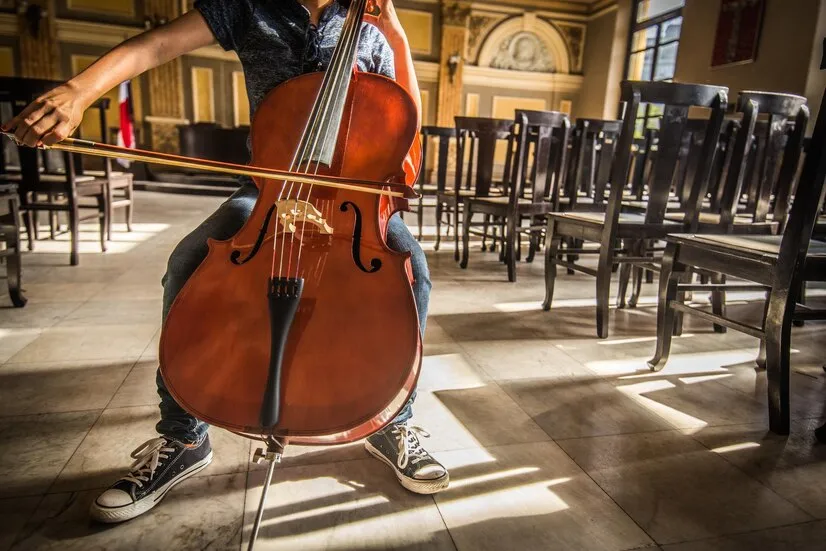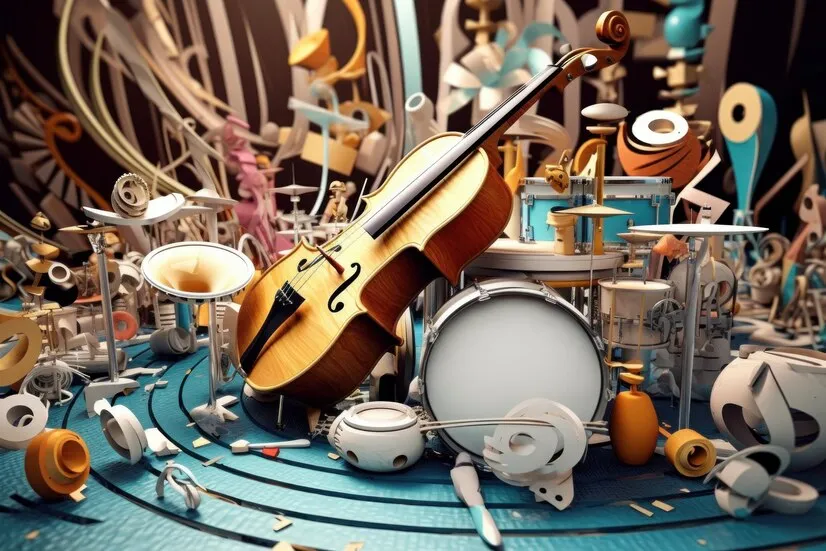The foundation of musical exploration is the wide variety of “types of instruments” that provide us with the opportunity to experiment with different sounds and textures.
On this illuminating excursion into “Unconventional Harmony: An Insight into Unusual and Unique Instruments,” we explore realms outside of the typical. From the didgeridoo’s earthy tones to the Theremin’s eerie beauty, we explore these remarkable musical instruments‘ cultural settings and unique characteristics.
An electronic wonder, the Theremin produces creepy, haunting tones when performed without touching the instrument. It exemplifies the limitless imagination of musicians from all walks of life. Contrarily, the didgeridoo, a wind instrument with deep, primitive earthiness played traditionally throughout Australia, provides a window into long-lost musical traditions.
Discover the fascinating world of unusual instruments, each adding narrative to the diverse musical heritage. Instruments like the didgeridoo and the Theremin, with their primordial resonance and otherworldly sounds, enrich musical compositions with nuance and feeling.
The Melodic Elegance of String Instruments
String instruments are the foundation of musical expression. Entrance into their lyrical elegance. In the grand orchestra of musical marvels, strings are special and treasured. People have been captivated by their mesmerising melodies and everlasting charm for ages.
Envision the timeless violin, all luscious curves and eerie beauty. The bow’s rich, resonant tone may express it all with each stroke, from the joy of a dance to the sorrow of a moving song. It is not surprising that playing the violin is a symbol of great talent and intense feeling.
Let us explore the double bass, whose resonant low end provides a solid foundation for the symphony. With its deep, resonant tones, the double bass—the lowest-pitched string in the family—is the foundation for musical creations.
String instruments weave a symphonic tapestry that allows us to experience the enchantment of their harmonies and the profound emotional impact they impart to music. From the lyrical grace and enduring charm of a solo violin to the roar of a double bass, string instruments wow audiences with their melodic sophistication and intricate details.
Exploring the Strings: From Violins to Cellos

The term “stringed instrument” is self-explanatory, as these musical instruments produce sound by means of vibrating strings. The complex classification system classifies many types as members of the “rope family”. Among these selections, the violin is best regarded for its remarkable flexibility and musical beauty. The violin’s unique characteristics have made it a wonderful place in orchestral, chamber and solo performances worldwide with its ability to evoke a wide range of emotions, from sad lament to dance ecstasy, in a pleasant manner.
The violin has become a symbol of exceptional musical power and intense emotion due to its lasting appeal and ability to evoke deep emotions. The violin, with its captivating sound and dynamic, expansive power, is a seductive instrument, an idea that can elevate any music, no matter the artist’s skill level.
Diving into Percussion Paradise
Percussion instruments are the next stop on our musical adventure. The percussion section of an orchestra provides the driving force behind the music, much like the strings provide for the heart of an orchestra.
Envision the resounding drums, captivating those who hear them with their dramatic presence and forceful beats. From rock and jazz to orchestral works, these rhythmic behemoths form the foundation of many musical styles.
Contrasting with this are the gentle chimes of bells, which give music a shimmering quality. These delicate, entrancing noises add depth and complexity to the musical tapestry.
Percussion instruments provide a wide range of tonalities and dynamics, from the thunderous bass drum to the detailed snare drum patterns. Their rhythmic vitality infuses any musical composition with a feeling of motion and excitement.
The Rhythmic Beats: Drums and More

Categorisation helps us better understand the various functions of percussion instruments. Sets are created for percussion instruments according to their shared features and musical applications.
Consider the drum, a classic percussion instrument that makes a sound when hit. Numerous drums exist, each with a unique tone and function, all belonging to the same family.
The snare drum adds a sharp, rhythmic quality, and the bass drum grabs attention with its deep, resonant tones. Musical compositions can benefit from adding percussion instruments, such as dazzling cymbals and vivid timpani. Their adaptability and dynamic range make them vital to the rhythmic backbone of many different styles, from rock bands to classical orchestras.
The Enchanting World of Woodwind and Brass
Explore the fascinating world of brass and wood machinery, which complement each other. Wooden instruments, such as flutes and clarinets, force air through a tube to create rhythmic sounds.
Brass instruments such as trombones, trumpets and French horns are sounded by being played by pressing the lips against a steel face and with their haunting faces and rhythms, these instruments steal the show for the orchestra.
Percussion in an orchestra relies heavily on the tones produced by woodwind and brass instruments. These instruments bring classical music to life, transporting listeners to a pulsating world with lyrical clarinet solos and powerful trumpet solos.
Winds of Melody: Clarinets to French Horns
Aerophones, which include woodwind and brass instruments, are a more general term for musical devices that use air to create sound. One of the most popular options in orchestras is the French horn, known for its beautiful, soothing sound.
Symphony orchestras worldwide hold the French horn in high esteem due to its distinctive design and distinctive sound. The instrument is a member of the brass family. From the gentle sorrow of a solo to the majesty of a fanfare, its rich, velvety tones may inspire various emotions.
The French horn’s expressiveness and flexibility enhance each performance’s quality. The haunting sound of the French horn, whether playing in the background or stealing the show, never fails to surprise audiences and inspire musicians around the world.
Beyond the Ordinary: Unusual and Unique Instruments
As we delve deeper into our exploration, we encounter instruments that don’t fit into any category, which makes us question what music is all about. The Theremin is an unusual instrument that creates sound without human touch. Instead, it uses the player’s airborne hand gestures to generate ethereal and supernatural sounds.
Because of its innovative construction, playing the Theremin requires no physical contact, unlike more conventional instruments. By controlling the electromagnetic fields surrounding the instrument, the musician may create gravity-defying, eerily beautiful songs.
Theremin is a favourite instrument of experimental, avant-garde musicians. His supernatural voice became a staple of the soundtrack to classic science fiction films. With its mysterious and supernatural nature, it enhances musical expression.
The Theremin: A Haunting Beauty
Because of its unforgettable sound, the Theremin is a popular instrument for experimental music and cinema scores. The player’s hands regulate the pitch and volume by moving near two metal antennae, creating a distinctive sound.
This hypnotic device blurs the boundary between science and art, giving insight into the boundless potential of musical innovation. The otherworldly and mysterious sound of the Theremin is incorporated into several soundscapes, elevating the film and its performance to a whole new level.
Designed without the touch of an instrument, the Theremin’s awe-inspiring and thought-provoking music attracts listeners and encourages its players to experiment with new sounds.
The Earthy Resonance of the Didgeridoo
The classic Australian didgeridoo is mesmerising with its rich, gritty sound. Its low, vibrating sound is powerful and primordial, yet it is made of wood. This instrument possesses a wealth of cultural heritage. It has been used in indigenous Australian music for ages. Even in modern times, the didgeridoo’s distinctive and expressive sound captivates listeners, revealing long-lost customs and profound ties to its homeland.
Embracing Cultural Diversity: Instruments Around the World
Recognising the varied musical traditions worldwide is vital as we explore odd instruments. Every country has a distinct collection of instruments that symbolise its historical and cultural heritage, such as the resonant banjo notes in American folk music or the enchanting flute tunes in Celtic music. The banjo’s unique resonance has deep historical roots in the United States, namely among the genres of bluegrass and country music.
It became a symbol of American musical culture due to the energetic and rhythmic tone it brought to traditional folk songs.
Conversely, the harp is revered in Celtic music for its role in creating evocative melodies that reverberate over bygone eras. With its gentle but powerful sound, it captures the spirit of Celtic history and mythology, conjuring up visions of mythical stories and foggy landscapes.
Like many others worldwide, these instruments are more than simply means of making music; they are carriers of heritage, tradition, and individuality. Through the sounds they produce, they bridge the gap between musical history and innovation, reflecting past and present generations’ stories.
Conclusion: Embracing Diversity in Music
In summary, there are many types of equipment available worldwide, ranging from the ordinary to the extraordinary. Strings, percussion, woodwind and brass each add their own sound to the rhythm, be it rhythms, melodies or exotic vocals Theremin and didgeridoo are unconventional instruments that showcase the boundless ingenuity of musicians across multiple eras.
Using non-traditional instruments can expand our horizons and deepen our appreciation of music. So, in the future, when you get pleasure from a band or learn about a new piece of music, take some time to acknowledge and appreciate the many instruments that contribute to the playing. Every instrument, from a simple to a fine instrument, through a unique element, is added to the rhythm of life.
Let’s explore the limits of what music can be and celebrate its unexpected associations. No matter how proficient you are in music or how much you love listening to music, there is always so much new knowledge to be had on different instruments, and I appreciate you joining me on this musical journey. Until our next meeting, keep actively participating and appreciate the diversity of music!


